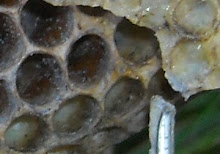There is nothing like the feel of an old barn at harvest time...full of the smell of fresh hay and drying root vegetables from a farmer's hard earned gardening efforts.
It brought back memories of my Papou Gus and his little farm with my grandma Sophia outside of Frederick, Colorado. Vivid images of my brother Jimmy and I running through the fields and wildflowers after dragonfly and grasshopper; pulling eggs out from under Papou's chickens and hiding them in hopes of another "weasel in my coop" story round the dinner table.
Now that I have ducks I realize those stories were very real concerns....but Gus would smile at us this gentle way and put up with our antics on those rare summer visits.
This sunny day in our New Hampshire farm and forest community, so many years later, I yielded about ten pounds of honey. All the frames were capped full. A handful of bees from the farmer's hive found us up there in the loft and buzzed in excitement. They clamored then to get out of the barn windows to let their find be known to their sisters.
I put the extracted frames back on my Italian hive first thing the next morning and placed the nuc box I used to transport them in to the backyard for the bees to clean up.
HONEY HARVEST TOTAL:
I've been saving my old comb filled with honey from my very first hive, not sure how to get it out. Finally, I found the space and got the equipment for crush & strain extraction, thanks to Linda's Bees advice here at blogspot. She put up some great photos and explanation on how to get honey out of the comb without an extractor. So nice to find another beekeeper on the web. Two pounds honey total from those old frames.
As far as this recent barn-harvest goes, I pulled six frames from my 2010 over-wintered hive. I made a decision to take honey even though the supers were light as I needed the experience. They yielded about 12 pounds. I can feed it back to them if needed, but it was great to go through the whole process finally after three seasons.




















